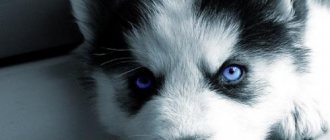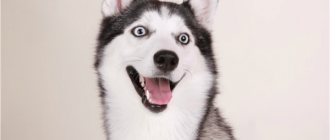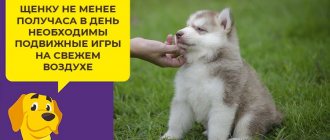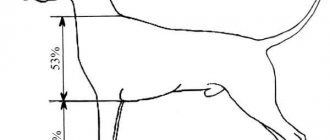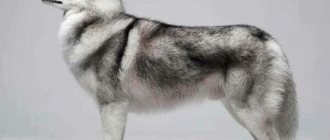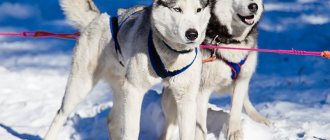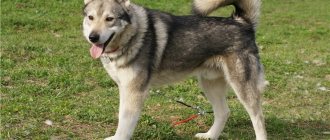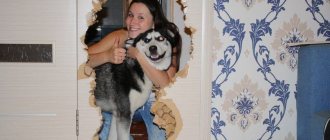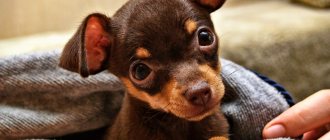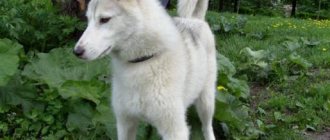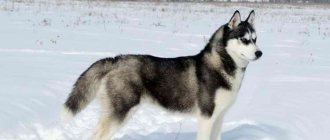Place to sleep
A husky puppy finds its new owners at the age of about 2 months; the first thing that needs to be built for the new family member is his permanent place. Despite the fact that animals can easily tolerate severe cold, you should not immediately place a baby under six months old on the street, as this is fraught with a cold and the development of pneumonia or cystitis. Up to 3 months, it is advisable for the pet to sleep in a warm room; from 4 to 6 months, it can be kept at temperatures up to -20 outside, leaving it overnight in an unheated room with bedding. From six months of age, dogs can easily tolerate being kept outdoors in enclosures; at night, the babies spend the night in insulated kennels on a bed of hay.
Adult huskies are best kept in spacious enclosures measuring at least 8 square meters. m per animal. The enclosure is fenced with an unpainted metal mesh 0.5 cm thick, which must be dug deep into the ground or reinforced into the foundation. Huskies love to dig, and if the home is built incorrectly, the animal may run away and never return. An insulated kennel with a flat roof is installed in the enclosure, where dogs like to spend time during the day.
When keeping Siberian beauties in an apartment or private house, it is necessary to allocate the coolest corner for the small pet, preferably covered with tiles. A wooden flooring with a mattress is installed in this place; you can lay several layers of soft material directly on the floor. The place of your four-legged friend should be away from drafts, entrance doors, heating appliances and wires.
A place for an animal is created once and for the rest of its life, both the puppy and the adult dog must unquestioningly know the “Place” command and go to their corner.
Why husky?
If the question arises about why you should choose this particular breed, there are many answers, but here are the main ones - huskies:
- beautiful;
- has an independent spirit, full of energy and enthusiasm, which she will always share with her family members;
- very affectionate and always very cheerful. The dog will try to give positive emotions to its owner, even if it itself is painfully ill;
- distinguished by piercing blue eyes, large beautiful ears and a very sociable character;
- at any opportunity, he will give his owner about a hundred licks per hour and will always try to cheer him up.
This breed is too amazing to be summed up with just ordinary words. Only direct contact with the dog itself can tell better.
Caring for a puppy and an adult animal
It is necessary to care for a growing dog from the first days of its appearance in a new place; with simple procedures, the owner achieves the trust and devotion of his little friend, and also takes care of his health and carries out the prevention of various canine pathologies. Caring for a husky puppy consists of the following simple activities:
- It is recommended to comb the coat of puppies a couple of times a week; the undercoat of adult dogs is removed 2 times a year during seasonal shedding.
- If huskies are heavily soiled, you can bathe them no more than 2 times a year; bathing babies before vaccination is strictly prohibited. It should be noted that Siberian dogs are very reluctant to tolerate water procedures, so you should not overdo it with them.
- Puppies and adult huskies need to inspect their ears 2 times a month for the accumulation of dirt, discharge or flares in them. Simultaneously with the examination, the ears are cleaned with a special lotion.
- It is recommended to start brushing your teeth from the age of 2 months to avoid the deposition of tartar and the development of dental pathologies. Dogs' teeth are cleaned with a children's toothbrush or a special dog brush using veterinary toothpastes.
- Huskies are vaccinated from the age of 2 months; up to a year, the puppy must receive three vaccinations with polyvalent vaccines. Before vaccination, the specialist must prescribe deworming and treatment against ectoparasites 10 days in advance. Further vaccination is carried out for adult dogs once a year according to the vaccination calendar.
- You can walk a small husky only from 3 months of age, when immunity is formed after the first vaccination. Huskies are very active dogs that require long-term daily exercise. When kept in an enclosure or on a chain, the animal must have enough space to frolic for several hours in the truest sense of the word. Apartment huskies require two active walks lasting from 2 to 4 hours at a time. Walking should consist of long runs over rough terrain; many owners do an excellent job of this function with the help of a bicycle.
Labski: Husky and Labrador Retriever mix
To begin with, it is worth examining the issue of motivation of breeders. As a rule, Labradors are crossed with sled dogs to achieve the following goals:
- Beautiful appearance. Unfortunately, in the modern world, the demand for puppies that are attractive in appearance is much higher than for puppies in good health. Inexperienced owners are not always ready to delve into all the intricacies of the acquisition, and are ready to choose a pet based on its beautiful eyes.
- Character. A cross between a Labrador and a Husky allows you to get calm puppies with a balanced psyche, inherited from the Labrador parent. At the same time, the mestizo gets an active character and attractive appearance from its husky parent.
Due to changes at the gene level, hybrids are prone to infertility. That is why it is not possible to develop a separate breed, the ancestors of which would be Siberian Huskies and Labrador Retrievers.
Important! All puppies are descendants of these two breeds in the first generation, and therefore the description of their appearance cannot be systematized.
Dimensions, weight and other differences
A Husky/Golden Retriever or Labrador related mix is a risky experiment and you can never really predict what the puppies will be like. It all depends on the parents and the extent to which they passed on their genes to their offspring.
As a rule, if the male is a husky and the female is a Labrador, then the build and physique of the male predominates. Puppies grow tall, of medium weight, with fluffy fur.
Additional Information! It is in this variation that the chance of getting a blue-eyed puppy increases - a distinctive characteristic thanks to which mestizos have become so widely known.
If, on the contrary, the male is a Labrador and the female is a husky, then the puppies will resemble a retriever in appearance and a sled dog in character. Such puppies are much less likely to inherit bright blue eyes. From Labradors they get their love of food and people-orientation.
Color
If character can be predicted in some way, then color is truly a random thing. As a rule, a puppy can inherit a color type from one of the parents, but the two colors will only be combined in color.
So, for example, the color type of retrievers can be inherited - monochromatic. Possible colors:
By analogy, a puppy can inherit a husky color type - a combination of the main color with white, with a characteristic arrangement of spots and the presence of a mask.
Unlike retrievers, huskies have no restrictions on the color standard, so the coat color can be any color. Most often, babies inherit color from their dad due to the predominance of his genes.
Home education
Husky is a very freedom-loving and quite wayward dog, which must be trained from puppyhood. If you miss this moment, you will get an uncontrollable dog that will sit on your neck. Socialization is the process of developing an adequate reaction in a dog to people. To do this, you need to play with the baby, pet him, and praise him so that the animal does not have fear of the person or the desire to attack him. Most Huskies have a very friendly nature; this breed is not intended for guard work. Siberian dogs are used mainly in sledding competitions, shows, or as pets.
A dog, especially a male, must see in its owner not only a friend, but also a leader, otherwise the animal will not respect and obey the person. To achieve the right relationship, you should not allow the animal to enter the kitchen, lie on sofas and armchairs, sleep in the same bed, and do mischief. Any dog, especially during adolescence and at the time of changing teeth, strives to gnaw on everything that comes to hand, to show character, to bite on the legs or arms. A good option during adolescence is a cage in which the animal is locked when the owners are away to save shoes and furniture. As you grow up and stop having dirty puppy habits. the cage can be removed
The most important thing is to punish your pet correctly so that the behavior is nipped in the bud, but the animal is not intimidated or harbors a grudge against the offender.
It is strictly forbidden to hit or shout at the husky, as this will make him your enemy!
The kids, like little children, are explained in a stern voice, slapped on the tail, older dogs are flicked on the nose, pressed to the ground by the withers for a few seconds, thrown onto their backs and severely scolded. The main thing is that the punishment follows immediately after the offense, and the owner always adheres to the same line of behavior.
It is necessary to love your animal, showing both severity and affection when raising it, then the husky pays its owner with selfless love and responsiveness.
How to distinguish a purebred husky from a crossbreed
The first and most important sign that a dog belongs to any breed is the presence of documents (pedigree and birth certificate). Without them, it is impossible to speak with absolute certainty about the breed of the animal.
However, unfortunately, in the modern world, documents are made so simply that they cannot always guarantee that a dog meets the standards of its breed. To call a dog a purebred, it must have the following:
- Documentation.
- Appearance corresponds to the breed standard. Even a dog from purebred parents can be born with a so-called defect.
- Behavior. Each breed is characterized by a certain temperament and general behavioral tendencies.
You can accurately determine whether a purebred husky is a crossbreed only when the puppy grows up. In the Siberian Husky breed standard there are no restrictions on colors, but there are characteristic features: a colored part of the fur coat on the upper body, a mask on the muzzle.
If the dog has a tail that is too short, ears that are too large, or is short and elongated (like a corgi), most likely it is just a lost dog passing off as a husky.
Leash training
A baby husky must be taught to use a leash from the age of 3 months; walking with a freedom-loving dog without a leash can result in the loss of the family pet. In addition, the domestic pet has very developed hunting instincts; the animal, when free-ranging, can attack small dogs, cats, poultry, and pigeons. Most often, huskies are trained only by obedience commands; in the absence of experience, it is recommended to entrust the education of the animal to professionals.
Leash training can be achieved by any owner with daily exercise, patience and affection. Classes will bring positive results, provided that the pet considers the owner to be the leader and completely trusts him. Leash training consists of several stages:
- We put on the equipment and watch the animal’s reaction; puppies of the aboriginal breed do not like a leash, some individuals are afraid or aggressively rush at it. At this moment, you need to calm the baby, pet him and try to walk the husky on a leash a little in short steps.
- If the animal refuses to walk, you need to pause without removing the leash and use small pull-ups to encourage the puppy to move. When the baby begins to move around in the harness, the owner should immediately praise and pet his pet.
- If the dog clearly does not want to wear equipment, you can resort to treats, but the owner’s actions should always be gentle, clear and persistent. The puppy must realize that resistance will not bring results, and in any case he will have to walk on a leash.
- Periodically, during the first lessons, it is necessary to remove the leash, calm the pet and give it time to run freely.
Over time, the animal will completely trust the owner and calmly endure the previously unpleasant procedure.
We hope that Khasenysh owners liked our article. The animal should always be calm and interesting with you; try to walk with it more often in new interesting places. Tell us about the antics of your graceful beauties.
Husky: breed standard and description of appearance + can a dog change with age
Huskies, originally bred and used for a long time as sled dogs, have now become popular as pets and as participants in various dog shows.
However, the fashion for representatives of this breed has led to the appearance of many puppies that do not meet the breed standard. There are also more and more cases when outbred mestizos are sold under the guise of huskies.
Every future owner of a Siberian Husky needs to carefully study the breed standard before going for a pet.
Some features of the breed
Before you rush to look for a place to buy a puppy, it is still worth knowing about some of the features of the husky. Despite all its advantages, this dog has some differences that may seem like significant disadvantages to some people, for example:
- Constant shedding, which intensifies from time to time. If you do not provide timely care to your dog's coat, the light hairs will constantly stick to clothes and envelop all surfaces in the house with their thick mass. The constant presence of fur on personal belongings will become an integral part of the life of the happy owner of this breed.
- Poor guard qualities. Huskies may look like wolves, but they have the heart of a Casanova. Some novice owners, due to their limited knowledge about this breed, are even afraid of their dogs, because they believe that it is a wolf hybrid. However, as the animal gets along with family members and what emotions it shows, people quickly realize that the only thing they have in common with the wolf is their appearance.
- These are independent dogs. Despite the too high level of love, huskies are distinguished by their individuality, which only intensifies with age, as does the dog’s intelligence. If a dog decides to catch up with a cat during a walk, then no demands from the owner will stop it.
- These are very energetic animals. Regardless of what the weather is like outside, the animal needs at least 4 hours of active walks per day, and it will behave the same in cold, heat or slush. A person can only envy such energy and run after his dog, taking upon himself all the delights of unfavorable weather.
What does the RKF standard look like?
The dog is medium in size, with a compact but not coarse build.
The body is rectangular, tending towards a square format, that is, the height at the withers should be only slightly less than the length of the body:
- The head is proportional, with a moderately defined transition to a muzzle slightly tapering towards the nose.
- The ears are erect, triangle-shaped with slightly rounded ends, medium in size, turned forward when interested.
- The eyes are slightly slanted and almond-shaped. Both dark and bluish-blue colors of the iris are acceptable, and the standard does not prohibit heterochromia.
- The nose is medium in size, with well-opened nostrils. Depending on the color, it can be black, or light or dark brown.
- The neck is medium in length, moderately arched, and raised when standing.
- The shoulder blades are located at an angle of 45 degrees, while straight or too loose shoulders are a serious drawback.
- The chest is strong, powerful and quite deep, but not too voluminous.
- The forelimbs are parallel and level, moderately wide apart, with the elbows fitting tightly to the body.
- The hind legs are parallel, also moderately wide apart, with well-muscled thighs and well-defined angulations of the hock joints.
- The tail is medium in length, resembling a fox's in appearance, carried either lowered or in the shape of a sickle. Twisted into a ring, thrown over the back or tucked between the hind legs is considered unacceptable.
For huskies, the so-called “snow” pigmentation of the nose is also considered acceptable, when there are light veins on a dark background.
